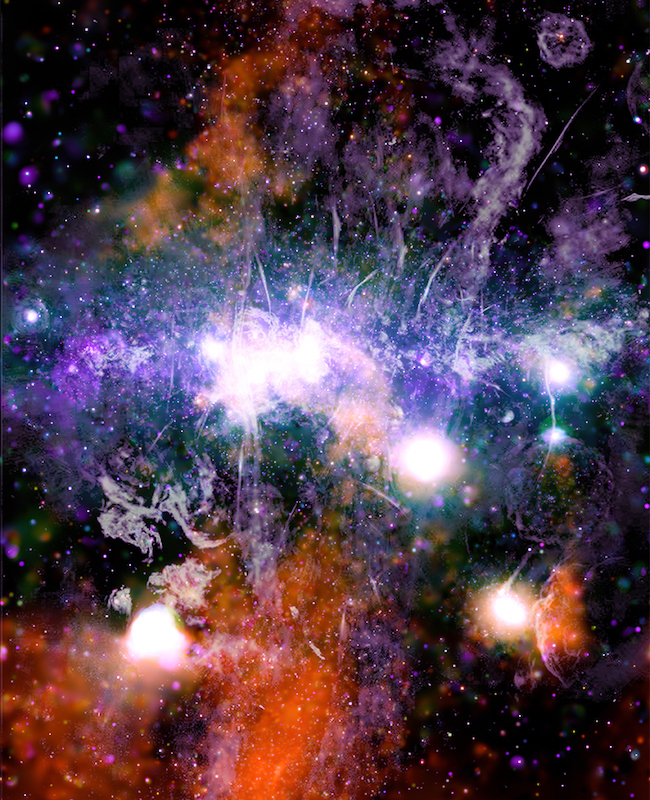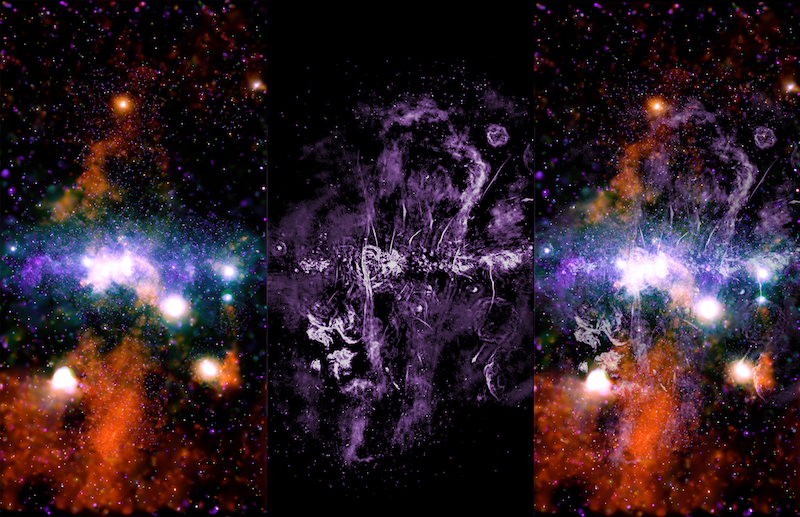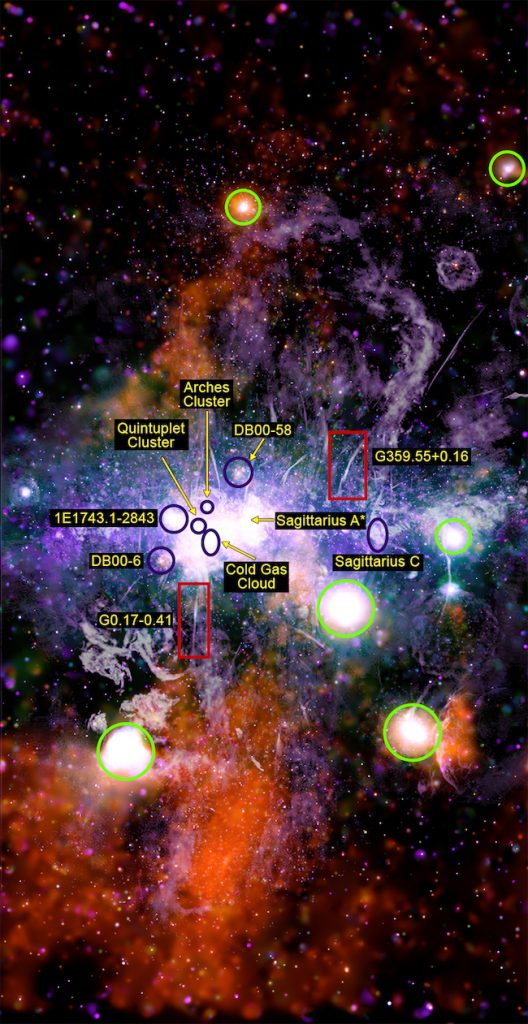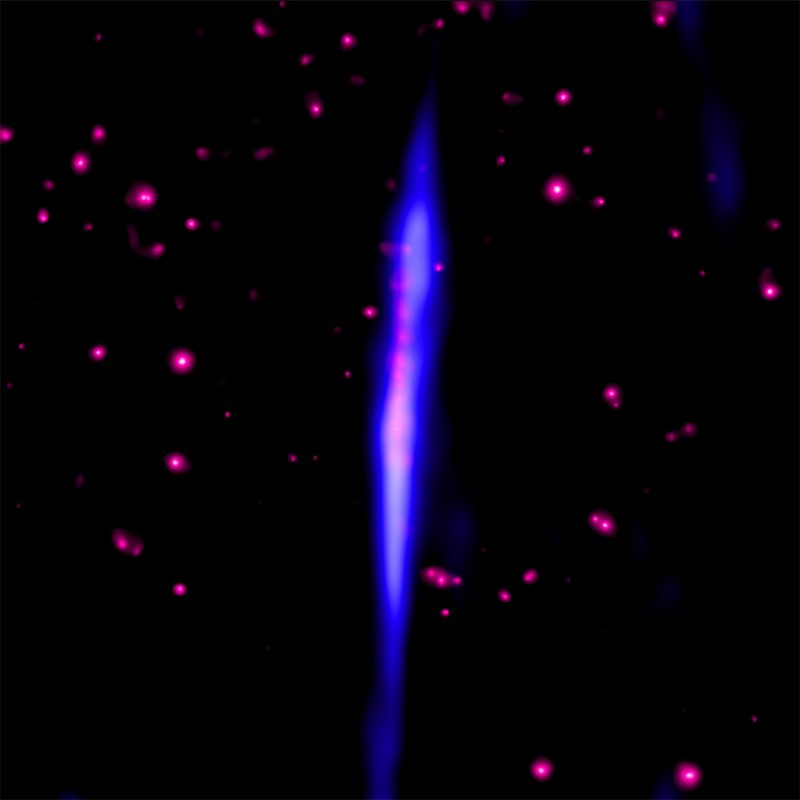
Dust hides the Milky Way center
Normally, the bright center of our home galaxy, the Milky Way, is hidden behind dust. The ordinary light we see with our eyes can’t pass through. But expand our vision (via telescopes and their instruments) to see different kinds of light – different wavelength regimes of the electromagnetic spectrum – and we can see through the dust. Then go a step further and combine several different kinds of “lights.” At that point, astronomers see fascinating new details, leading to new insights.
Astronomer Q. Daniel Wang of the University of Massachusetts Amherst did just this. He used high-energy X-ray data, gathered over two decades, combined with new low-energy radio data. The result, released on May 27, 2021, is an extraordinary new image of the central region of our Milky Way.
Thread-like superheated gas and magnetic fields
A portion of the new image is shown at the top of this post. It covers a region, 2,000 light-years thick, above and below the core of our galaxy. Fascinatingly, the new image reveals intriguing threads of superheated gas and magnetic fields.
Wang published the image and accompanying results in the June 2021 edition of peer-reviewed journal Monthly Notices of the Royal Astronomical Society.
As intriguing as these results are, Q. Daniel Wang, author of the paper, wasn’t surprised. He told EarthSky:
Not really, although I felt humbled. After all, we know that the [Milky Way] galaxy is a complex ecosystem. It will be a long way to truly understand how it works.
How did astronomers make the new image?
Wang stitched together X-ray data observed at 370 different telescope pointings – different aims at the sky to increase the field of view – at three different energy levels. He gave the energy levels – different frequency bands – the colors orange, green and purple and combined them. (This is similar to how different frequencies of visible light have different colors and combine into color images in our eyes.) These X-ray data were observed with the Chandra X-ray telescope over some 20 years. Among them are data Wang was in charge of, as the successful telescope – operating since 1999 – made its first large-scale X-ray survey of the Milky Way center.
In addition, the high-energy X-ray data were combined with low-energy radio observations (shown in grey and lilac) from the new South-African radio telescope MeerKAT.


Magnetic threads in Milky Way center
Astronomers can measure the magnetic field of something when cosmic rays get caught in the field and spiral around the field lines. That spiraling causes detectable radio emission.
The combined image reveals superheated gas (X-ray) and magnetic fields (radio) of the gas forming thread-like formations near the Milky Way center. A NASA statement explains how these are thought to be formed:
Such strips may have formed when magnetic fields aligned in different directions, collided, and became twisted around each other in a process called magnetic reconnection.
This is similar to the phenomenon that drives energetic particles away from the sun and is responsible for the space weather that sometimes affects Earth.
In other words, much as there is a kind of space weather in our solar system, so there is a large-scale space weather near the center of our home galaxy. The galaxy’s weather has a different cause. It’s driven by violent happenings such as supernova explosions and outbursts of matter from the region near the central supermassive black hole, Sagittarius A*. In the big picture, the galaxy’s space weather could explain how our galaxy is evolving. Wang said:
We know the centers of galaxies are where the action is and play an enormous role in their evolution.
A magnetized thread of particular interest
There are a few cases where the radio and X-ray appear in the same feature. In particular, a long thin thread called G0.17-0.41 is 25 light-years in length, but exceedingly thin.

Wang told EarthSky that finding the cause to this thread carried the biggest surprise:
It was so difficult to explain G0.17-0.41 by any well known mechanisms (for example a pulsar wind nebula or supernova remnant). Magnetic reconnection seems to be the only feasible mechanism.
In fact, this particular thread provided the strongest evidence, Wang pointed out:
This pair of the X-ray thread/radio filament really gives the key evidence for the magnetic reconnection and annihilation, as highlighted in the paper. The radio filament is locally fattened by the presence of the X-ray thread, clearly indicating the dynamic association. The X-ray probably traces the hot gas heated by the annihilation, while the radio is emitted by the cosmic ray electrons accelerated by the reconnection.
Now, why are the thread-like features more visible in radio? Why don’t they all have counterparts in both X-ray and radio? Wang explained:
The magnetic field has to be strong enough to produce X-rays. But reconnection events should in general accelerate cosmic rays [shown in radio]. A reconnection is a dynamic process and comes and goes, although the time scale in the interstellar medium should be much longer than in a solar flare.

There is still much to do. Wang told EarthSky the next steps:
I’d like to confirm that magnetic reconnections are indeed responsible for many of the X-ray threads and radio filaments observed in the region and to see how effectively magnetic fields are transporting the energy from the center to large-scale structures and releasing it there.
Bottom line: By stitching together two decades worth of X-ray data from the Chandra space telescope and combining with radio data, astronomer Q. Daniel Wang has created a new image of the central region of our Milky Way galaxy. The image reveals magnetized threads stretching out large distances from the inner region.











